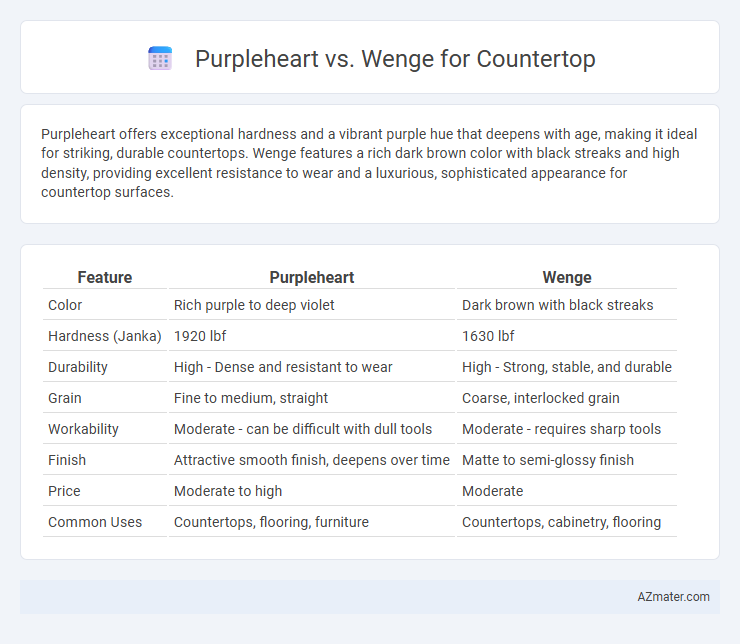Purpleheart offers exceptional hardness and a vibrant purple hue that deepens with age, making it ideal for striking, durable countertops. Wenge features a rich dark brown color with black streaks and high density, providing excellent resistance to wear and a luxurious, sophisticated appearance for countertop surfaces.
Table of Comparison
| Feature | Purpleheart | Wenge |
|---|---|---|
| Color | Rich purple to deep violet | Dark brown with black streaks |
| Hardness (Janka) | 1920 lbf | 1630 lbf |
| Durability | High - Dense and resistant to wear | High - Strong, stable, and durable |
| Grain | Fine to medium, straight | Coarse, interlocked grain |
| Workability | Moderate - can be difficult with dull tools | Moderate - requires sharp tools |
| Finish | Attractive smooth finish, deepens over time | Matte to semi-glossy finish |
| Price | Moderate to high | Moderate |
| Common Uses | Countertops, flooring, furniture | Countertops, cabinetry, flooring |
Introduction to Purpleheart and Wenge Countertops
Purpleheart countertops showcase vibrant purples and deep hues, renowned for their exceptional durability and natural resistance to moisture and decay, making them ideal for high-traffic kitchen areas. Wenge countertops stand out with striking dark brown to almost black tones, featuring a coarse grain and remarkable hardness that provides excellent scratch and impact resistance. Both hardwood options offer unique aesthetic appeal and longevity, making them popular choices for functional and stylish kitchen surfaces.
Origin and Botanical Differences
Purpleheart originates from the Peltogyne genus, primarily found in Central and South American rainforests, known for its vibrant purple hue that deepens with age. Wenge comes from the Millettia laurentii tree native to the Congo region in Central Africa, characterized by its dark brown and black streaks creating a distinctive zebra-like grain. Botanically, Purpleheart belongs to the Fabaceae family, producing dense, durable wood, while Wenge, also in Fabaceae, differs with coarser texture and a more open grain structure suitable for heavy-use surfaces like countertops.
Appearance: Color, Grain, and Unique Features
Purpleheart countertops showcase a rich, vibrant purple hue that intensifies with age, featuring a straight to interlocked grain pattern with a smooth texture. In contrast, Wenge offers a deep, dark brown to black color with subtle lighter streaks and a striking, coarse, and interwoven grain that provides a dramatic appearance. Unique to Purpleheart is its color transformation from a muted violet to a bold purple over time, while Wenge's characteristic dark tones and pronounced grain create an exotic, luxurious aesthetic ideal for high-end countertops.
Hardness and Durability Comparison
Purpleheart wood ranks around 2,520 on the Janka hardness scale, offering impressive resistance to dents and wear, while Wenge measures slightly lower at 1,930. In terms of durability, Purpleheart exhibits excellent resistance to decay and insect attacks, making it suitable for heavy-use countertops. Wenge also offers good durability but tends to be more prone to surface wear and requires more maintenance to preserve its appearance over time.
Resistance to Moisture and Wear
Purpleheart, known for its dense grain and natural oils, offers excellent resistance to moisture, making it a reliable choice for countertops exposed to water. Wenge, similarly dense and tough, demonstrates superior wear resistance, with a robust hardness rating that resists scratches and dents effectively. Both woods provide durability, but Purpleheart excels in moisture resistance while Wenge leads in withstanding everyday wear and tear.
Maintenance and Longevity
Purpleheart countertops offer exceptional durability with natural resistance to decay and wear, requiring regular oiling to maintain their vibrant color and prevent drying. Wenge countertops boast a dense, hard grain that provides excellent scratch and moisture resistance, demanding minimal maintenance other than periodic cleaning and occasional oiling to preserve their dark, rich appearance. Both woods ensure long-lasting countertops, but Purpleheart's color may deepen over time, while Wenge maintains consistent tone with proper upkeep.
Workability and Installation Challenges
Purpleheart wood offers moderate workability with decent resistance to wear, but its hardness can cause increased dulling of tools during countertop shaping. Wenge is significantly harder and denser, leading to more challenging machining and greater risk of splintering, which complicates both cutting and installation processes. Both woods require sharp, carbide-tipped tools and careful handling to achieve precise joints and smooth finishes in countertop applications.
Cost and Availability
Purpleheart countertops typically cost between $15 to $25 per square foot, making them moderately priced compared to other exotic hardwoods, but their availability can be limited due to regional sourcing mostly from Central and South America. Wenge, sourced primarily from West Africa, often ranges from $20 to $30 per square foot, reflecting its higher market demand and denser wood characteristics, but supply can be inconsistent due to export restrictions and sustainable harvesting regulations. Both woods offer durability for countertops, yet Purpleheart tends to be more accessible in North America, while Wenge may require special ordering and longer lead times.
Environmental Impact and Sustainability
Purpleheart and Wenge are both tropical hardwoods known for their durability and rich colors, but their environmental impact varies significantly. Purpleheart, often harvested from sustainably managed forests in Central and South America, tends to have a lower carbon footprint due to faster growth rates and certification availability such as FSC. Wenge, primarily sourced from African rainforests, faces concerns related to habitat destruction and illegal logging, making it less sustainable and increasing its environmental impact.
Which Wood Is Best for Your Countertop?
Purpleheart offers exceptional durability and a rich violet hue that deepens over time, making it ideal for countertops that require both strength and striking appearance. Wenge features a dark, dense grain pattern with high resistance to wear and moisture, suitable for countertops in high-traffic kitchens. Choosing between Purpleheart and Wenge depends on whether you prioritize vibrant color variation with long-term patina or a consistently dark, modern look with superior hardness.

Infographic: Purpleheart vs Wenge for Countertop
 azmater.com
azmater.com